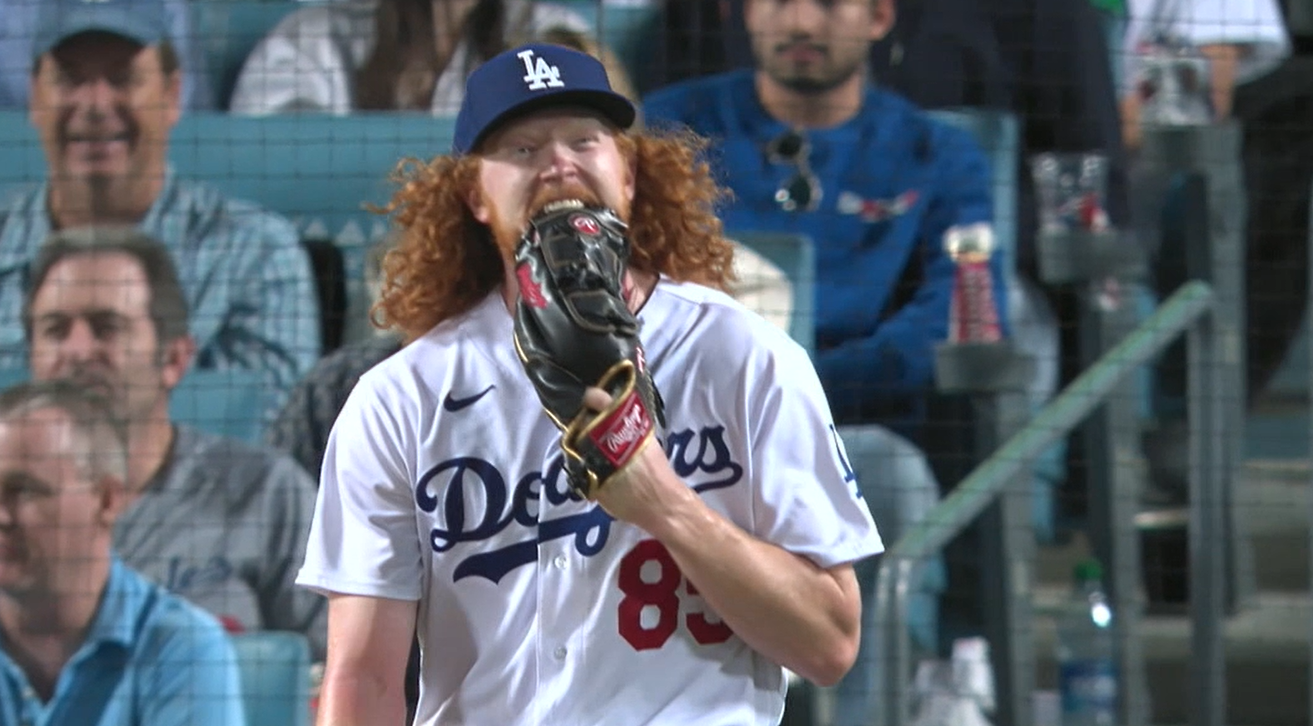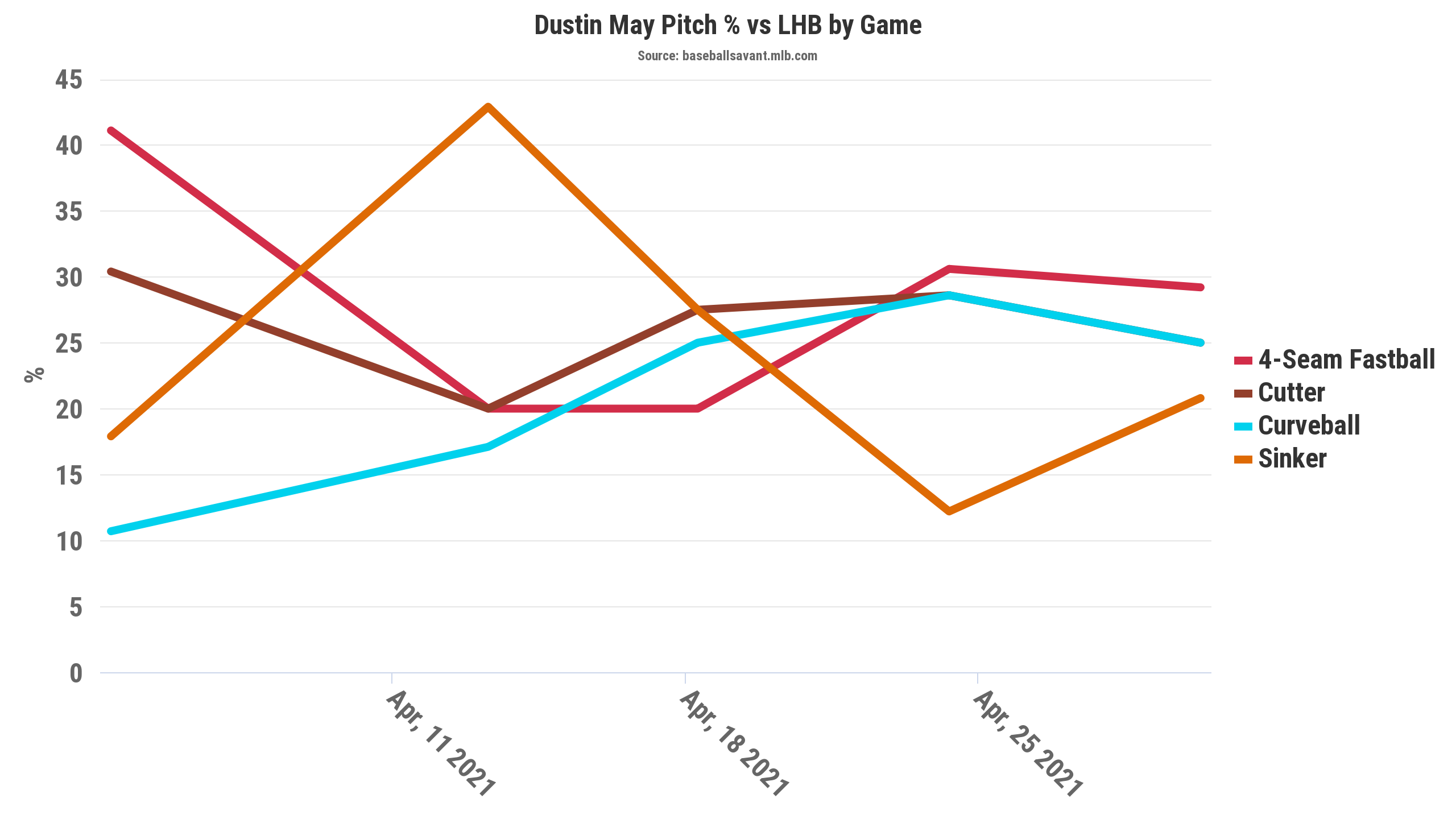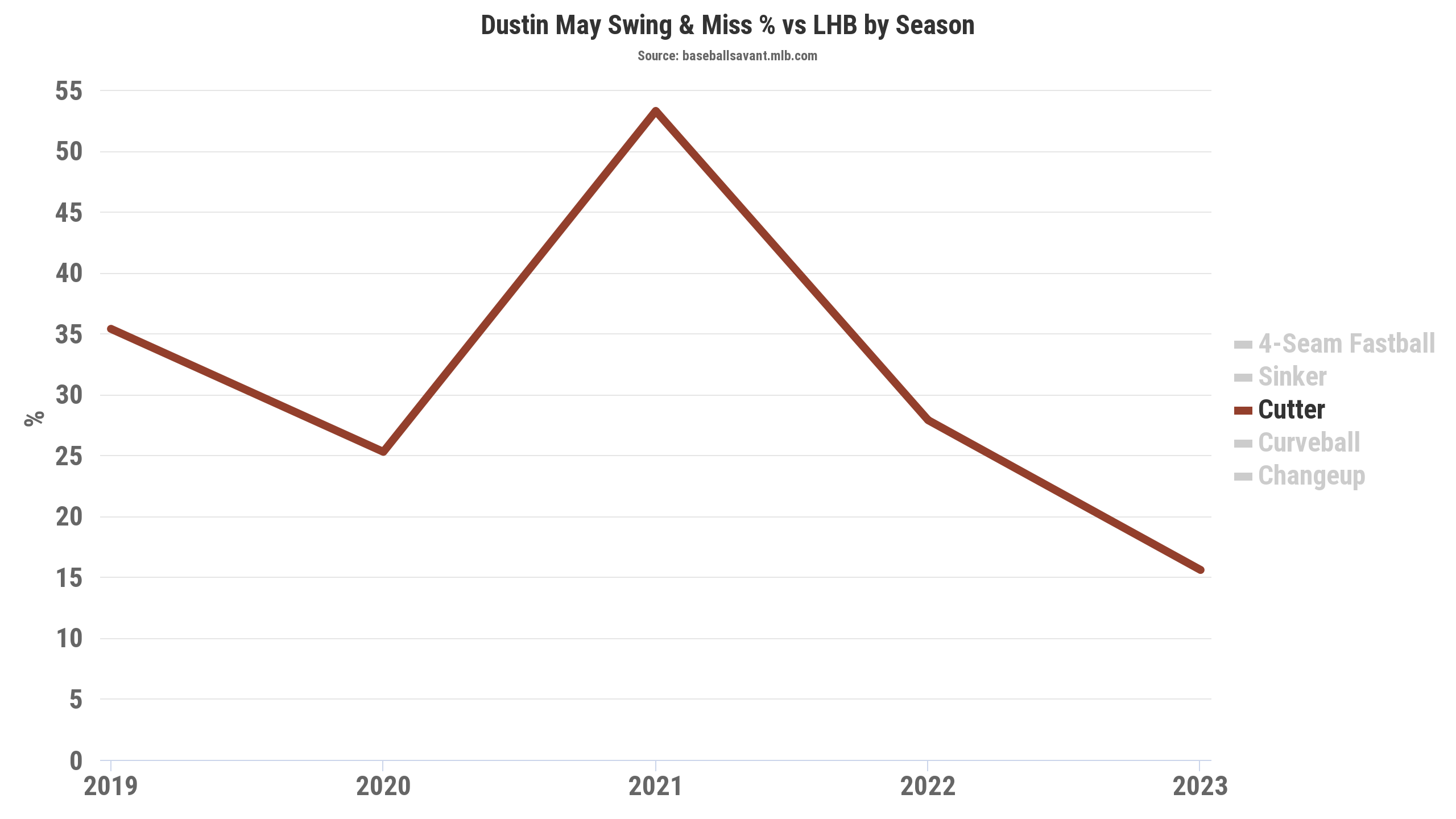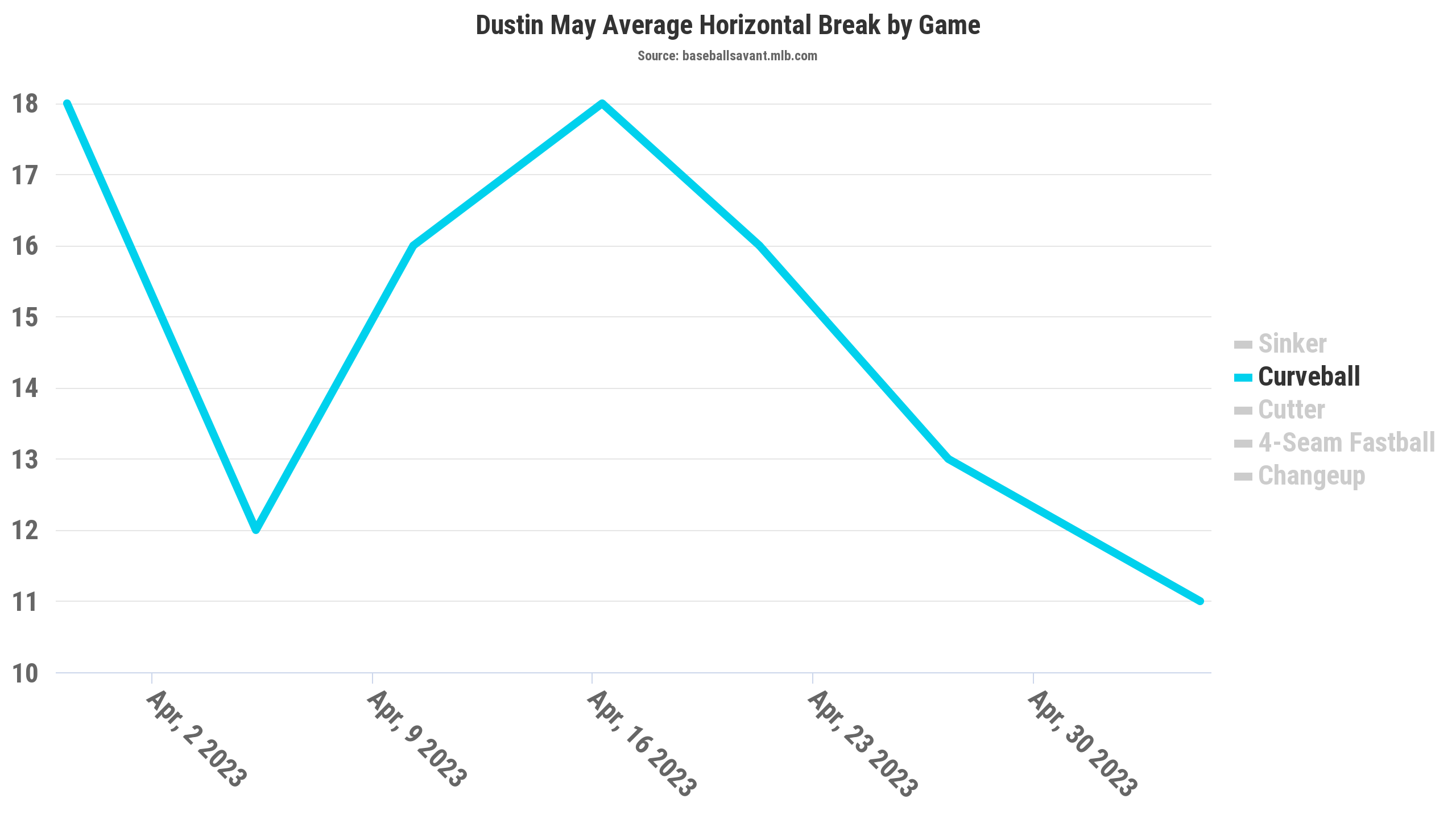Dustin May‘s Major League debut came back on Aug. 2, 2019 against the Padres. Back then he was a 21-year-old with his 22nd birthday a little more than a month away, and he allowed four runs (three earned) in 5 2/3 innings with three strikeouts and no walks. May threw 61.9% sinkers, 25.8% cutters and 9.3% curveballs with a few changeups added in, and eventually finished the 2019 season with 14 regular season appearances and two more in the postseason.
A year later, with his pitch types similar and extension stabilized (from a range of 5.9 to 6.4 to the 6.5 and 6.6 it is today), May’s four-seam fastball landed fourth on the team at 116 on the Stuff+ charts, while his curve ranked third at 116. His innings were limited due to injury, but May’s curve moved to first on the team in 2021 at 163 (and second in baseball among pitchers with his inning total), the sinker tied for third at 119 and the fastball ranked second at 135.
Now in 2023, May’s Stuff+ rating of 121 is tied for fifth among qualified pitchers, led by the league’s highest ranked curve at 146, the second-best sinker at 118, the seventh-best cutter at 109 and the ninth-best fastball at 117.
Despite those grades, May and the Dodgers have not stopped tinkering with both his pitch mix and pitch usage, seemingly in an attempt to find an answer to his weakness of not getting the whiffs of an elite-level pitcher.
——
Given the stuff he has, it shouldn’t really be a surprise that May stepped up for the Dodgers with 6 shutout innings against the Padres back on Saturday night at Petco Park as the Dodgers bounced back from a disappointing series opener.
Yet, all these years later, he’s still not missing many bats with a career-low Whiff% of 16.2, a zone contact rate of 84.9% that’s his highest since 2020 and a chase contact rate of 76.6% that’s up from 64.4% in 2020, 41.9% in 2021 and 47.7% in 2022. In fact, May hasn’t reached a Whiff% of 24.7 (right around league average) once this season, and that’s helped lead to a career-low 18.4 K%. Instead, May’s been getting by with a .198 BABIP that’s the fourth-lowest in baseball this season, and a career BABIP of .245 that’s tied for 41st lowest in baseball history.
May finishing with just three misses on 40 swings against the Padres isn’t ideal, though unsurprisingly two of them came on seven swings against his “curveball”, a pitch that might be showing the most evolution. Of May’s six strikeouts, four came looking, with Juan Soto staring at a sinker down in the zone that broke back away from him, Ha-Seong Kim watching a pair of sinkers appear to be outside before breaking back over the plate, and both Matt Carpenter and Trent Grisham looking at cutters.
The two swing and misses that did finish off strikeouts against Manny Machado and Brett Sullivan were the curve, with the latter taking it off his knee.
Notably, May threw 52 sinkers among his 99 pitches with 14 cutters, 14 curveballs, 11 fastballs and eight changeups. For various reasons, just about all of that is notable once you take a look through his career pitching totals.
——
Sinker
Before I get too deep into all the tweaks in May’s pitch usage, it’s worth noting that this is still very difficult to evaluate given that he’s pitched in 44 career regular season games spread across five seasons, plus nine postseason games back in 2019 and 2020. The longest consistent pitching stretch of May’s career came in the abbreviated 2020 season, which really lasted just three months from the end of July to the end of October and consisted of 19 total appearances. And more importantly, these changes in specific usage really only apply to his approach to left-handed batters.
Because here’s how his career looks against right-handed batters.
With that said, May hadn’t used the sinker that much overall since April 14, 2021. That’s the span of just 15 games, but that happens to be more than 33% of May’s regular season career. Back in 2020, the only “complete” season of May’s career, the sinker usage never fell below 44% in his 12 appearances and finished at 51.4% for the year. But after making a change in approach a few starts into 2021, May returned in 2022 with the cutter and fastball leading the way against left-handed batters.
And here’s 2023, with the past two outings really showing the switch. As you saw in the clip above, the left-handed Soto watched the arm-side run of the pitch break into the corner of the zone for strike three.
Fastball
The increase in sinkers correlates with an overall drop in May’s four-seam usage that has really come back down to where it traditionally had been, with the left-handed batter usage again responsible for this dip (as seen above). After throwing the pitch at least 40 percent of the time in his first three starts, May has steadily come back down, using it 24.1% of the time on April 17 against the Mets, May went to 21.9%, 18.3% and then 11.1% against the Padres.
Cutter
Whether it is a coincidence or a direct result, as May increased his overall sinker/fastball usage, the cutter’s Whiff% steadily dropped down. That’s true of batters on both sides of the plate, but is more impactful for lefties as May understandably uses the pitch more often to them specifically.
The cutter is averaging 93.2 mph in 2023, so that’s another 13.8% of his pitches coming in just a few mph slower than the 61.9% combined usage of his four-seamer and sinker. Those three pitches span about 11 inches difference in their vertical movement, leaving about three-quarters of May’s pitches … well:
Curveball
All of that brings us to May’s curveball, which is seeing a movement change and maybe a new name, in the middle of the season.
From an 18-inch horizontal break and 45-inch vertical on April 17 at 85 mph to 11 inches and 35 inches at 87.6 mph on May 6. Digging through the semantics of pitch names and all that, a 35-inch drop would be the lowest for a curve in the league on Baseball Savant, and that shape actually just starts to look like this.
Evan Phillips is averaging 33.8 inches of vertical movement and 13.1 inches horizontally at 85.3 mph on his sweeper. Yency Almonte‘s 33.8 inches vertically and 11.8 inches horizontally at 83.5 mph is also a similar look, but Zack Wheeler‘s 34.5 inches of vertical movement and 11 inches horizontally at 85.2 mph might be the closest example by the numbers.
The change in his curveball shape isn’t the only adjustment in recent starts, as May’s horizontal release has trended back to the left a bit to where it has been over the past two seasons after starting a bit further to the right in 2023.
Pitch Mix
May’s curve had been his best swing and miss pitch against right-handed batters, but like all of his pitches it has been down in 2023.
It’s missed bats against lefties during his career as well, but it wasn’t alone in being able to do so.
It’s a bit difficult to nail down exactly what May’s best combination of pitches is to generate more strikeouts given the stop and start nature of his career so far. But back in May’s 23 innings he pitched in 2021, he struck out 37.6% of batters compared to a 6.5 BB%. The velocity and movement of those pitches looked like this:
| Pitch | Velocity | Vertical Movement (inches) | Horizontal Movement (inches) | Usage |
| 4-Seam | 98.3 | 12.7 | 10.2 | 19.0% |
| Sinker | 97.8 | 19.9 | 18.7 | 39.7% |
| Cutter | 93.0 | 25.7 | 0.8 | 18.5% |
| Curve | 86.6 | 41.3 | 15.2 | 22.8% |
And when you look at where it stands through seven starts this season, it’s not too different other than the drop in sinker and cutter use, with a rise in four-seam usage.
| Pitch | Velocity | Vertical Movement (inches) | Horizontal Movement (inches) | Usage |
| 4-Seam | 97.4 | 13.2 | 9.9 | 28.5% |
| Sinker | 96.7 | 19.9 | 18.2 | 33.4% |
| Cutter | 93.2 | 24.1 | 0.7 | 13.8% |
| Curve | 86.1 | 40.4 | 14.9 | 20.7% |
| Change | 90.8 | 28.6 | 17.0 | 3.7% |
While May had plenty of strikeout success in those four completed starts, it should probably go without saying that we have no idea how the rest of that season would have turned out. Vertically, the four-seamer and cutter have both moved closer to the sinker in 2023. With the curve now gradually moving toward all three pitches as well over these past few starts, May really is leaning on a horizontal game. As the curve morphs into a sweeper, it seems like a curve more similar to his 2019 pitch (53.9 inches of movement) may be useful to actually take advantage of the fastballs he can throw, as Daniel mentions in his tweet.
Unless May and the Dodgers make another adjustment to his usage as the curve transitions into a sweeper, May’s going to primarily be sinker and sweeper to right-handed batters with an occasional cutter or fastball. For lefties, it’s back to the sinker with an even mix of his other four offerings. Either way, neither approach seems to be headed for more swings and misses at the moment despite the tinkering.
——
Given where May’s stuff ranks against the rest of the league, we shouldn’t be surprised the contact it’s generating in the air hasn’t hurt him too badly and he’s keeping his BABIP so low. But a pitcher this naturally talented can’t be sitting in the 24th percentile of the league in strikeout rate and the 3rd percentile in the league in whiff rate.
Another meeting with the Padres is ahead tomorrow, the second consecutive season May will have to face San Diego in back-to-back starts. Last September, that meant a slight change in approach the second time out, as May flipped the usage of his four-seamer/cutter and his sinker/curve to lefties while right-handers went from seeing four pitches between 39% and 10% to being primarily sinker and curve the second time out.
It’ll be interesting to see what May and the Dodgers do, not only to the Padres who get another look so soon after their first opportunity this season, but also over the rest of the season as they continue to search for a solution to help May take the next step that he’s so clearly capable of.
 Dodgers Digest Los Angeles Dodgers Baseball Blog
Dodgers Digest Los Angeles Dodgers Baseball Blog











